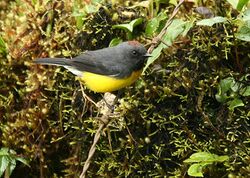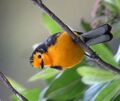Biology:Whitestart
| Whitestart | |
|---|---|

| |
| Slate-throated whitestart, Myioborus miniatus | |
| Scientific classification Error creating thumbnail: Unable to save thumbnail to destination
| |
| Domain: | Eukaryota |
| Kingdom: | Animalia |
| Phylum: | Chordata |
| Class: | Aves |
| Order: | Passeriformes |
| Family: | Parulidae |
| Genus: | Myioborus Baird, 1865 |
| Type species | |
| Setophaga verticalis[1] d'Orbigny & Lafresnaye, 1837
| |
| Species | |
|
See text | |
Whitestarts are New World warblers in the genus Myioborus. The English name refers to the white outer tail feathers which are a prominent feature of the members of this genus ("start" is an archaic word for "tail"). The species in this genus are also often called "redstarts".
The stronghold of the whitestarts is northern South America, although a few species range along the Andes as far south as north-western Argentina , while others range north through Central America and as far north as the United States, in the case of the painted whitestart. Most species are restricted to mountain forest and woodland. The ancestral Myioborus warblers, together with those in the genus Basileuterus seem to have colonised South America early, perhaps before it was linked to the northern continent, and these two genera provide most of the resident warbler species of that region.
Name
Whitestart is the name used for all species in this genus by the International Ornithological Congress,[2] while the Clements checklist, and the American Ornithological Society's North and South American Classification Committeess use "redstart".[3][4][5] Myioborus species are not closely related to the various species called redstarts in the family Muscicapidae or to the American Redstart.
Species
The genus contains 12 species:[2]
| Image | Scientific name | Common Name | Distribution |
|---|---|---|---|
 |
Myioborus pictus | Painted whitestart | Arizona and New Mexico in the southern United States to Oaxaca,Veracruz and Chiapas in Mexico to northern Nicaragua. |
 |
Myioborus miniatus | Slate-throated whitestart | Mexico, Central America, the Andes from western Venezuela to northwestern Argentina, the Venezuelan Coastal Range, Sierra Nevada de Santa Marta and the tepuis |
 |
Myioborus brunniceps | Brown-capped whitestart | Bolivia and north-western Argentina |
 |
Myioborus flavivertex | Yellow-crowned whitestart | Santa Marta Mountains in Colombia. |
| Myioborus albifrons | White-fronted whitestart | western Venezuela | |
 |
Myioborus ornatus | Golden-fronted whitestart | Andes of Colombia and far western Venezuela. |
 |
Myioborus melanocephalus | Spectacled whitestart | southern Colombia to Bolivia |
 |
Myioborus torquatus | Collared whitestart | Costa Rica and western-central Panama |
| Myioborus pariae | Paria whitestart | Paria Peninsula in Venezuela | |
| Myioborus albifacies | White-faced whitestart | tepuis of south-western Venezuela | |
| Myioborus cardonai | Guaiquinima whitestart | Cerro Guaiquinima in south-eastern Venezuela. | |
| Myioborus castaneocapilla | Tepui whitestart | Tepuis in southern Venezuela, western Guyana and northern Brazil. |
Descriptions
Most whitestarts are 13–13.5 cm (5.1–5.3 in) long with dark grey or dark olive-green upperparts, except for the white outer tail feathers which are frequently spread in display. Adults have brightly coloured red, orange or yellow bellies. Many species have contrasting black, rufous or yellow caps or distinctive facial patterns, often with white or yellow "spectacles" around the eye.
The painted whitestart, the most northern form, is larger (15 cm (5.9 in) long) and has a different plumage pattern, song and behaviour from the other whitestarts. It is also the only species which is partially migratory, and it could perhaps be placed in a separate genus.
The sexes are similar, as with most resident tropical warblers, since they pair for life, and have little need of sexual dimorphism, unlike many migratory species where the males need to reclaim territory and advertise for mates each year.
Distribution and habitat
The whitestarts are resident in mountain (including tepui) forest, woodland and shrub, where they feed on insects, sometimes as part of a mixed-species feeding flock.
References
- ↑ "Parulidae". The Trust for Avian Systematics. https://www.aviansystematics.org/4th-edition-checklist?viewfamilies=197.
- ↑ 2.0 2.1 Gill, Frank; Donsker, David, eds (2019). "New World warblers, mitrospingid tanagers". International Ornithologists' Union. https://www.worldbirdnames.org/bow/warblers/. Retrieved 12 September 2019.
- ↑ "Checklist of North and Middle American Birds". American Ornithological Society. http://checklist.aou.org/. Retrieved 23 January 2020.
- ↑ "South American Checklist". American Ornithological Society. https://americanornithology.org/publications/south-american-checklist/. Retrieved 23 January 2020.
- ↑ "Clements Checklist". https://www.birds.cornell.edu/clementschecklist/. Retrieved 23 January 2020.
- Curson, Quinn and Beadle, New World Warblers ISBN:0-7136-3932-6
- Stiles and Skutch, A guide to the birds of Costa Rica ISBN:0-8014-9600-4
Wikidata ☰ Q134909 entry
 |

